Usually, when globetrotting is challenging, it’s because Derek and I can’t find enough information on a country, such as recipes, or films or other cultural elements. China poses the complete opposite problem: there’s so much. Recipes and restaurants were hard to pick this weekend, because there are many, and with only so much time, we have to be selective. That one is not Chinese enough. This one is also too Americanized. Do we really want this to be representative of Chinese culture? I’m no expert on Chinese culture, but I’m of Chinese descent (New York-born and bred, but both of my parents were born in Asia), and I definitely know more about China than I have about a lot of our other countries so far.
Other than Canada, China is the one country we’ve globetrotted to so far that I’ve visited in person (almost twenty years ago). Here’s a photo from the Great Wall:

Well, that’s enough for a preamble. Ni hao! And since Lunar New Year was last Monday, xin nian kuai le! Happy New Year!
We began Saturday with jian bing, savory breakfast crepes, which are a common street food in Beijing, and some tieguanyin (a Chinese oolong) tea.
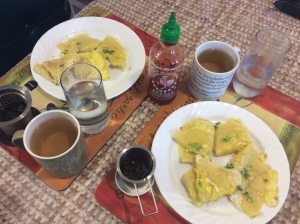
After breakfast, we watched a video from Journeyman Pictures, which interviews seven residents from the city of Nanjing, about what it’s like to live in the world’s fastest growing superpower. The short documentary touches upon issues such as the environment, political corruption, and technology.
For lunch, we took the T into Boston and visited Gene’s Chinese Flatbread Cafe, on the outskirts of Chinatown. Despite what its name might suggest, Gene’s is actually known for its hand-pulled noodles, rather than flatbread. Derek’s cumin lamb hand pulled noodles are on the left, and my hand-pulled noodles are on the right:
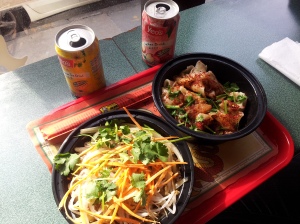
True to their name, hand-pulled noodles are made by hand, and we could hear the chef at Gene’s slapping dough against the kitchen counter, pulling the dough into noodle strands. (YouTube has quite a few videos of chefs hand-pulling noodles, like this one.) Here’s a close-up of my noodles—garlicky and spicy and very good:

After finishing our meals, we walked into Chinatown proper, through the Chinatown Park on the Greenway: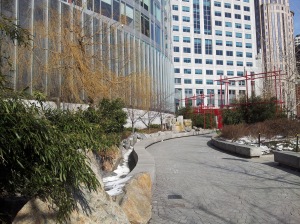
And through the Chinatown gate:

We stopped at Sweet Kingdom, an eatery that specializes in Asian desserts. Most Chinese don’t have big sweet tooths (though this writer is an exception), so Asian desserts tend to be much less sweet than Western ones. They are often fruit-based, like the dishes we ordered. The dish I chose, the Durian Kingdom, is on the left, and Derek’s Mango Kingdom is on the right. Both dishes were lightly sweetened, chilled tapioca soups with mango chunks, though Derek’s had mango ice cream and puree and mine had vanilla ice cream and durian puree.

Since Derek’s quite fond of the bakeries in Chinatown, our trip to the neighborhood wasn’t complete until we visited into a few and buying some baked goods for later. This is 101 Bakery, one of our usual go-to places:
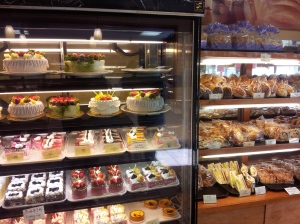
Even though it was bitter cold, Chinatown was still pretty busy. But unlike the people waiting outside in the cold to eat at some of the neighborhood’s most popular restaurants, we decided not to linger any longer, and headed home.
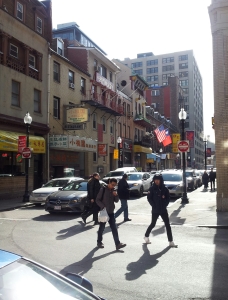
We shared one of our bakery treats at home, a pineapple bun. Pineapple buns don’t actually contain pineapple, but get their name because the golden checkered top kind of looks like the outside of a pineapple. We had this with some more tea.
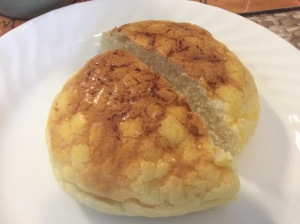
We also turned to what’s become a globetrotting standby, Geography Now, for its take on China. Like us, the show also found it a challenge to capture all the complexities of China. And as I started preparing dinner, Derek found us an interesting radio documentary for us to listen to, about how mangoes became an object of reverence during the height of the Cultural Revolution in China.
For dinner, we had lo han jai, also often called Buddha’s Delight, which is a stir fry of numerous vegetables and vegetarian proteins. It’s commonly eaten on Chinese New Year. There are many different versions of this dish, but you can find the recipe I followed here. We ate this with rice and more tea.
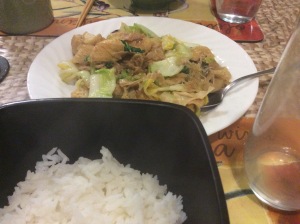
Afterwards, we watched the Chinese epic, To Live, by Chinese director Zhang Yimou, who is probably best known to American audiences for also directing Hero and House of Flying Daggers in the early 2000s. To Live is one of his earlier works, based on a novel written by the Chinese novelist Yu Hua, follows a married couple beginning in 1940s China, and into the 1960s, when the Cultural Revolution was taking place. Here’s the trailer:
The movie gave me an idea of what life in early Communist China was like, and what could have motivated both sets of my grandparents to leave mainland China. (My father’s family moved to Taiwan, while my mother’s family initially moved to Hong Kong, and eventually Peru.)
For a snack during the movie, we shared a sugar bun (top) and a pineapple pastry (bottom—this actually contained pineapple filling), both of which were purchased in Chinatown earlier in the day.
On Sunday, Derek woke up early to make us congee, rice porridge. Typically congee is made with a meat-based broth, but he found a vegetarian recipe. Congee is a very common breakfast food, and is also often given to the sick (it was a main source of food for me shortly after I got my wisdom teeth out years ago). Our congee was darker than usual because of the vegetable broth we used, and I can’t say that I’ve ever had chopped carrots and bok choy in my congee before, but this was still nice and comforting for a frigid February morning.
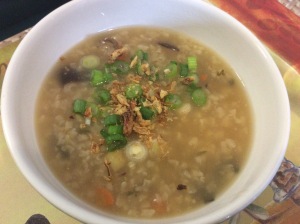
After breakfast, we watched a documentary about Tibet, and numerous communities established outside Tibet by exiles. While the previous evening’s movie showed us how Han Chinese (the ethnic majority in China) suffered under political upheavals, this documentary illustrated the struggles of the Tibetan ethnic minority.
Sunday lunch was dan dan noodles, a Sichuan noodle dish traditionally made with ground pork, and often with peanuts and/or peanut butter. Our version was vegetarian-friendly (with mushrooms instead of pork), and peanut-free (with tahini in place of peanut butter). I also chopped up some pickled mustard greens, and sautéed those with edamame and sliced bean curd sheets as a simple vegetable dish.
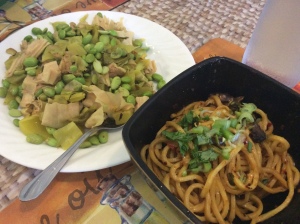
Later in the afternoon, we enjoyed the last of our bakery purchases, wife cakes, which are a flaky pastry filled with a candied winter melon paste. (Some versions of the pastry also contain almond paste, but luckily for us, these did not, so Derek could enjoy them, too.) There are a lot of legends about the origins of wife cake, most of which involve a wife being selfless or resourceful, for the sake of her family.
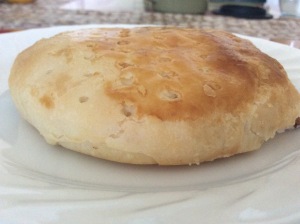
We’re also learning (or in my case, re-learning) Mandarin through an app called HelloChinese, which is similar in style to the multi-language app Duolingo. Derek’s screen below looks especially festive because of the New Year. So far the content has been familiar to me, but I have to give Derek a lot of credit for learning a new language with an entirely different character system. Even though I learned some Chinese when I was young (and have forgotten it through lack of use), I know that Chinese is really hard.
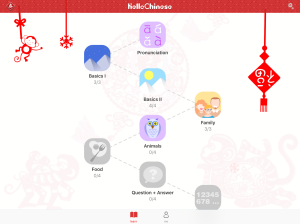
Since it was Valentine’s Day, Derek really wanted to go out to dinner somewhere, even though the wind chill outside was still in the negative. Luckily, our neighborhood has a number of Chinese restaurants, so we could go out for Valentine’s Day and still continue our globetrot. We decided to try Happy Lamb Hot Pot, a restaurant which just opened this week, and happens to be just a block from our apartment.
With hot pot, you select a type (or types) of broth, and platters of the meats/vegetables/tofu/noodles that you want from the menu. The servers will turn on the electric hot plate on your table, and bring over a pot with the broth(s) you’ve chosen. (Most hot pots have sections that can be inserted, so you can have two types of broth heating in the same pot.) Then, the waitstaff will bring the meats, vegetables and other ingredients you’ve ordered, so you can start cooking them right at the table in your pot.
Here you can see our pot of broths in the upper left, with Derek’s meat-based broth (it looks whitish in the picture) to the far left, and my mushroom vegetarian broth to the right of that. In the middle is the tofu sampler platter, and next to that, you’ll see a bowl of green vegetables, and a platter of thinly sliced beef and lamb. The bowl in the lower left contains fresh noodles.
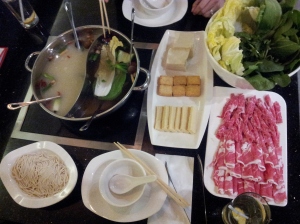
It was a nice Valentine’s Day dinner, though that may have had to do more with the company than the food itself (which was pretty tasty).
Back at the apartment, we watched a romantic comedy from Hong Kong called Needing You, which features Hong Kong pop singers Andy Lau and Sammi Cheng in the lead roles. The lighthearted story was a nice change from the more grim films we watched earlier, but the opposites attract storyline was often hard to believe. Here’s the trailer, which unfortunately doesn’t have English subtitles:
Since Monday was Presidents Day, we were able to extend our globetrot in China one more day. We began Monday with more congee and tea, and did chores for the coming work week. For lunch, we had more dan dan noodles, after I went out to buy more noodles to boil and serve with the extra sauce we had from the day before.
In the afternoon, we watched the documentary The Raw and the Cooked, which takes viewers on a culinary tour of Taiwan, starting in its capital, Taipei, to various indigenous communities, a Buddhist monastery, and farms in several parts of the country. The documentary introduces us to restaurant chefs, environmentalists, and farmers, all of whom take pride in the food of their island. (I was surprised, however, to not even catch a passing reference to the one Taiwanese food I know, stinky tofu.)
For our final meal, Derek made Taiwanese sticky rice cakes, and stir-fried baby bok choy.
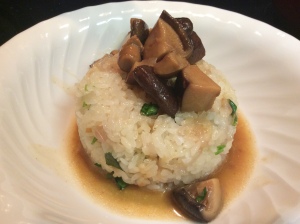
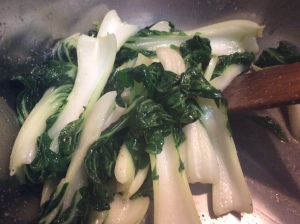
This is our longest globetrotting post to date, and yet there are lots of foods (e.g., Peking duck, dim sum, and the foods of China’s ethnic minorities), and lots of cultural activities (e.g., the Peabody Essex Museum’s excellent Chinese house, the Yin Yu Tang, and the Chinese art collections at numerous other local museums) that we didn’t get to experience. Even with the long weekend, there was no way we could cover all of China. Even our customary photo, displaying foods and other products of the country to which we’re globetrotting, doesn’t contain everything Chinese in our household, though it’s already quite a busy picture.
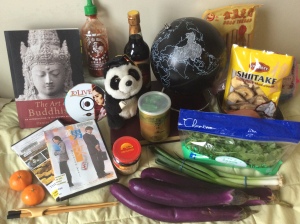
We’re always glad when we find a lot of things to do (and foods to eat) for our globetrots, and that’s certainly the case with China. But because of my personal connection with Chinese culture, the fact that we were able to do so much this weekend is especially meaningful. And Derek also enjoyed getting better acquainted with Chinese culture, and the resources we have here in the Boston area. This is a globetrotting country that we’ll definitely come back to–until next time, zai jian!
– Jess
Wonderful post. I feel like I’ve been to China!